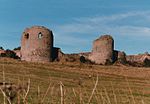Chartley Moss
Bogs of EnglandLandforms of StaffordshireNature reserves in StaffordshireSites of Special Scientific Interest in StaffordshireSites of Special Scientific Interest notified in 1987

Chartley Moss is a 105.80 hectare biological Site of Special Scientific Interest in Staffordshire, notified in 1987. The area has been designated as an Area of Outstanding Natural Beauty, a Ramsar Convention protected wetland site, and a national nature reserve. There is no access without a permit.In 1995 Chartley Moss was twinned with Tsukigaumi Mire, Hokkaido, in a gesture of goodwill between scientists from Hokkaido University and the University of Nottingham.
Excerpt from the Wikipedia article Chartley Moss (License: CC BY-SA 3.0, Authors, Images).Chartley Moss
Geographical coordinates (GPS) Address Nearby Places Show on map
Geographical coordinates (GPS)
| Latitude | Longitude |
|---|---|
| N 52.851692 ° | E -1.961017 ° |
Address
Stowe-by-Chartley
England, United Kingdom
Open on Google Maps











